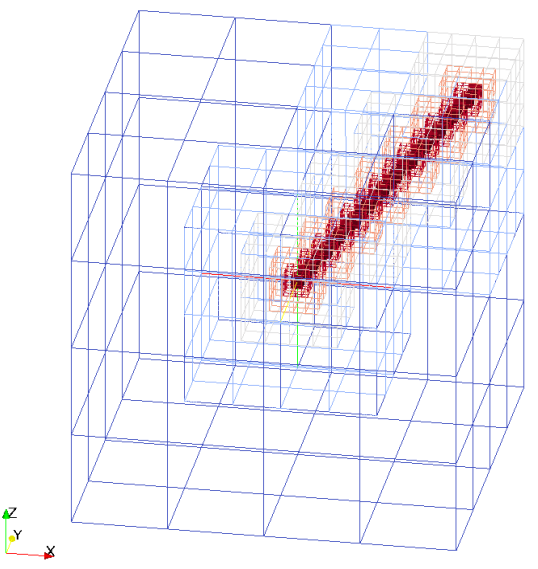Line
Lines are defined in the configuration file through canonical geometry kind with an origin and vector defining the length and direction of the line.
Valid definition:
- Single line
geometry = {
kind = 'canoND',
object = {
origin = { 0.0,0.0,0.0 },
vec = { 2.0,0.0,0.0 }
}
}
- Multiple line
geometry = {
kind = 'canoND',
object = {
{
origin = { 0.0,0.0,0.0 },
vec = { 2.0,0.0,0.0 }
},
{
origin = { 1.0,0.0,0.0 },
vec = { 0.0,2.0,0.0 }
},
}
}
Seeder file to generate the mesh with line is generated using above canonical geometry kind and the code is given below:
-- This is the standard seeder configuration, that should document the possible
-- and required configuration options.
-- It should always run out of the box!
-- ------------------------------------------------------------------------- --
-- Location to write the mesh in.
-- Note the trailing path seperator, needed, if all mesh files should be -- in a directory. This directory has to exist before running Seeder in
-- this case!
folder = 'mesh/'
-- Some comment, you might want to put into the mesh file for later
-- reference.
comment = 'Simple Sample Seeder Mesh'
-- Debug output can be used to output preliminary tree in restart format
-- and this restart file can be converted to vtu format by Harvester
debug = { debugMode = true, debugFiles = false, debugMesh = 'debug/' }
-- Bounding cube: the root node of the octree, defining the complete universe,
-- from which all elements are derived by recursive bisection.
-- The origin is the corner from which on the cube is spanned with the given
-- length in each direction.
bounding_cube = { origin = {-1.0, -1.0, -1.0},
length = 2.0 }
-- A minimum level, by which all parts in the computational domain should at
-- least be resolved with. Default is 0.
minlevel = 6
-- *********************** Table of spatial objects *********************** --
-- Each spatial object is defined by an attribute and some geometric entity
-- attached to this attribute. Attributes might be defined multiple times.
-- Attributes are described by a kind (boundary, seed or refinement), a level
-- and maybe further kind specific values, like a label for the boundary.
-- Geometric objects might by right now:
-- - canoND (point, line, plane or box)
-- - STL
-- - Sphere
-- - Cylinder
--
-- Periodic boundaries are special, spatial objects of this kind can only make
-- use of geometric objects of the kind 'periodic'.
spatial_object = {
{
-- Defining a domain boundary
attribute = { kind = 'boundary', -- or seed, refinement
label = 'solid', -- some label to identify the boundary
-- condition
level = 1 -- level to refine this object with,
-- default = 0
},
-- Example for line
-- It is also possible to define multiple lines
geometry = {
kind = 'canoND',
object = {
origin = {-1.0,0.0,0.0},
vec = {0.0,2.0,0.0}
}
},
-- Transformation of line
-- transformation = {
-- translation = {1.0,0.0,0.0},
-- deformation = {
-- { 0.0, 0.5*math.cos(45*math.pi/180), -0.5*math.sin(45*math.pi/180) },
-- { 0.0, 0.5*math.sin(45*math.pi/180), 0.5*math.cos(45*math.pi/180) },
-- { 0.5, 0.0, 0.0 }
-- } -- rotate the line along x-axis in anti-clockwise
-- direction
-- -- and scale by 0.5
-- }
},
{
-- Defining a seed to identify the part of the computational domain in
-- the universe cube.
attribute = { kind = 'seed' },
geometry = { -- single point definition with a canoND object.
kind = 'canoND',
object = { origin = {-0.0, -1.0, -1.0} }
}
}
} -- end of spatial objects
-- ************************************************************************ --
The mesh generated with line inside mesh:


Example lua file is available at testsuite/line/seeder.lua.